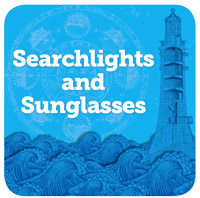
Five ways college journalism educators can use new Knight digital book
Knight Foundation asked the students, educators and professionals who beta tested our new digital teaching tool, “Searchlights and Sunglasses,” for their five favorite lessons. The book explores the digital transformation of journalism, and with one click turns into a classroom tool, offering a learning layer with 1,000 lesson plans and resources for educators. We have been posting our beta testers’ responses over the coming weeks here on KnightBlog.
Here, Cindy Royal of Texas State University, offers her top ways to use the book in the classroom.
“Searchlights and Sunglasses: Field Notes From the Digital Age of Journalism,” created by Knight Foundation’s Eric Newton is a project that introduces teachers at all levels to the challenges and opportunities of the news business. The role of digital media – primarily in the form of the Internet and Web, including social media and mobile platforms – has caused dramatic shifts and disruption to the way news is disseminated and the ways in which we teach journalism. It has introduced new competitors and partners and changed the long-held revenue models of journalism organizations. As teachers, we can no longer continue to teach about models that no longer exist. We need to prepare students for the future, which increasingly means preparing them for roles that may not exist yet.
Here are my top five lessons from “Searchlights and Sunglasses” that I feel best apply to college instruction: RELATED LINKS
Continue the conversation with #edshift and at edshift.org.
“Pencils down everyone. Your digital toolbox is here’: Five lessons from ‘Searchlight and Sunglasses” on KnightBlog
“Getting students to ask tough questions: My 5 favorite parts of “Searchlights and Sunglasses” on KnightBlog
“Navigating Knight’s new book: Choose Your Own Adventure” on KnightBlog
“Journalism educators, this $1M is for you” on KnightBlog
1. The exponential change in the evolution of human communication: Media has always had the need to evolve, but the first chapter of of the book highlights the rapid pace of change in the current environment. This sets the stage for the critical need for rethinking journalism education that is evident throughout the text.
2. The plight of journalism education: Chapter Two clearly outlines the current state of journalism education. Every journalism teacher must be aware of the “urgent necessity” to experiment and reform curriculum to reflect modern practices. We must also understand the importance of training students in digital literacy. This chapter provides examples of schools that have made progressive changes and offers suggestions for implementation. Strategies include collaborative teaching and learning, hosting hackathons and engaging with professionals.
3. The Learning Layer: Each chapter is supplemented by suggested questions, readings and activities and most are developed at three levels – Flashlight, Spotlight and Searchlight – to address high school, community college and university audiences respectively. You can find these exercises in the sidebar of each chapter integrated with the topics supported. Activities include encouraging students to identify skills needed for a career in news, discussing journalism education models and exploration of investigative reporting.
4. Resources: Within the text of the project, there are links to many resources that provide background to the digital age and could supplement college instruction. References to projects like the Tow Center’s Post Industrial Journalism Project demonstrate the range of outside resources that were used in developing this text.
5. Progressive digital tools and platforms: The site goes into detail on several progressive projects, including Ushahidi, Document Cloud and Spot.us, all projects initially funded by Knight Foundation. Journalism teachers need to be aware of the role that innovation projects play in the media ecosystem and prepare students to engage with entrepreneurial endeavors.
Cindy Royal is a 2013-14 John S. Knight Journalism Fellow at Stanford University and a professor at Texas State University.
Recent Content
-
Journalismarticle ·
-
Journalismarticle ·
-
Journalismarticle ·



